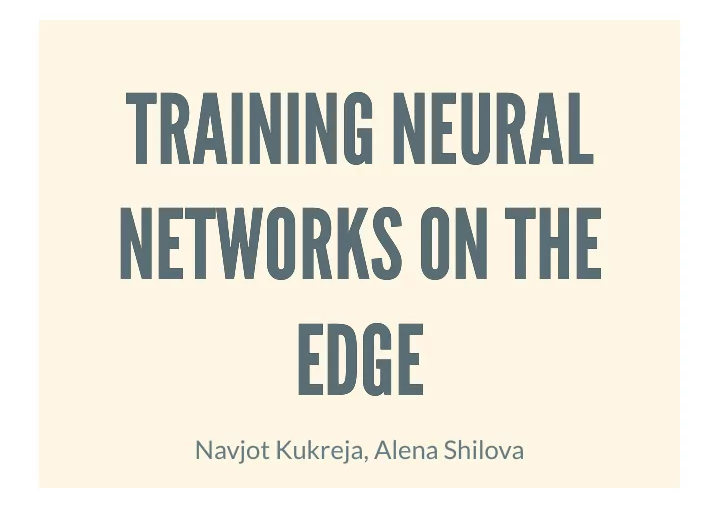

TRAINING NEURAL TRAINING NEURAL NETWORKS ON THE NETWORKS ON THE EDGE EDGE Navjot Kukreja, Alena Shilova
Also: Olivier Beaumont Jan Huckelheim Nicola Ferrier Paul Hovland Gerard Gorman
BACKGROUND BACKGROUND
Typical data �ow pattern for adjoint problems
Memory consumption during an adjoint problem
Checkpointing (Revolve)
S e tup Forward step Executing forward step Saved forward step Reverse step Executing reverse step Reverse step completed
Where else do we see the same data-access pattern? VGGNet
ARRAY OF THINGS ARRAY OF THINGS
WAGGLE PAYLOAD COMPUTER WAGGLE PAYLOAD COMPUTER ODROID XU4 based on the Samsung Exynos5422 CPU four A15 cores, four A7 cores Mali-T628 MP6 GPU that supports OpenCL, 2GB LPDDR3 RAM attached �ash storage
VIEWPOINT PROBLEM VIEWPOINT PROBLEM
STUDENT-TEACHER MODEL STUDENT-TEACHER MODEL
CHALLENGES CHALLENGES Network (not a challenge) Storage (not a challenge) Computation (not necessarily a challenge) Memory!
MEMORY REQUIRED TO TRAIN RESNET MEMORY REQUIRED TO TRAIN RESNET
Memory required (MB) for image size $224 \times 224$
Memory required (MB) for batch size 1
Memory required (GB) for batch size 8
CHECKPOINTING CHECKPOINTING
PyTorch fast-evolving Python package widely applied in deep learning uses Tensors as a basic class Tensors are similar to NumPy arrays which also allow to work with them on GPU dynamically de�nes the computational graph of the model designed to be memory ef�cient: there is checkpointing strategy
Checkpoint sequential: number of segments = 2
Checkpoint sequential: number of segments = 2
Checkpoint sequential: number of segments = 2
Checkpoint sequential: number of segments = 2
Checkpoint sequential: number of segments = 2 $$ \mbox{Memory} = s - 1 + \bigl(l - \left\l�oor l/s \right\r�oor (s -1) \bigr). $$
Revolve: dynamic programming $$ \small{\mbox{Opt}[\ell,1] = \frac{\ell (\ell +1)}{2} u_f + (\ell+1 ) u_b}$$ $$\small{\mbox{Opt}[1, c] = u_f +2 u_b}$$ $$\small{\mbox{Opt}[\ell, c] = \min_{1 \leq i \leq \ell-1} ( i u_f +\mbox{Opt}[\ell - i, c -1] + \mbox{Opt}[i-1, c]) }$$
Comparison of Checkpoint sequential and Revolve Batch Size: $1$, Image Size: $224 \times 224$
Batch Size: $8$, Image Size: $224 \times 224$
Batch Size: $1$, Image Size: $500 \times 500$
Batch Size: $8$, Image Size: $500 \times 500$
PRACTICAL IMPLEMENTATION AND PRACTICAL IMPLEMENTATION AND CONCLUDING REMARKS CONCLUDING REMARKS
THANK YOU THANK YOU
Recommend
More recommend